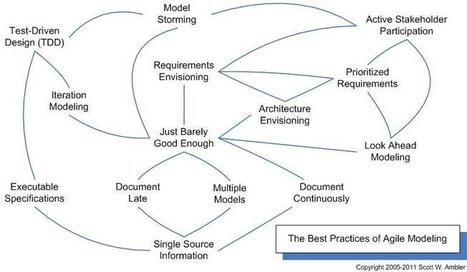Agile Modeling (AM) is a practice-based methodology for effective modeling and documentation. Models are sometimes called maps or roadmaps within the agile community. Agile models can be something as simple as stickies on a wall, sketches on a whiteboard, diagrams captured digitally via a drawing tool, or executable models captured using a model-based software engineering (MBSE) tool. Agile documents can be something as simple as point-form notes, detailed text, executable tests, or one or more agile models.
Research and publish the best content.
Get Started for FREE
Sign up with Facebook Sign up with X
I don't have a Facebook or a X account
Already have an account: Login
For Product Owners/Product Managers and Scrum Teams: Growth Hacking, Devops, Agile, Lean for IT, Lean Startup, customer centric, software quality...
Curated by
Mickael Ruau
 Your new post is loading... Your new post is loading...
 Your new post is loading... Your new post is loading...
|
|














Agile Modeling Strategies
Mindset
Values of
Agile Modeling
Principles
of Agile Modeling
Disciplined Agile
Mindset
People
Generalizing
Specialists
Active Stakeholder
Participation
Inclusive Tools
& Techniques
Disciplines
Agile
Requirements
Agile
Analysis
Agile
Design
Agile
Architecture
Agile Enterprise
Architecture (EA)
Agile
Data Modeling
Modeling Strategies
Multiple
Models
Just Barely
Good Enough (JBGE)
Modeling Sessions
Agile Modeling
Session
Look-Ahead
Modeling
Model
Storming
Session Types
Requirements
Envisioning
Architectural
Envisioning
Iteration/Sprint
Modeling
Specification Strategies
Agile
Documentation
Executable
Specifications
Test-Driven
Development (TDD)
Document
Continuously
Document
Late
Single Source
Information
Related Techniques
Prioritized Work
Agile Legacy
System Analysis
Other Pages At This Site:
Important External Links